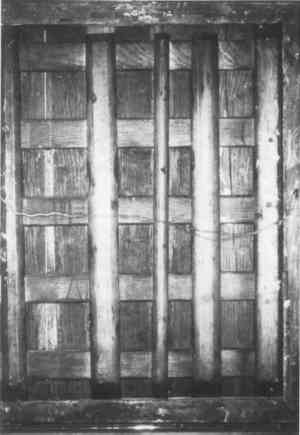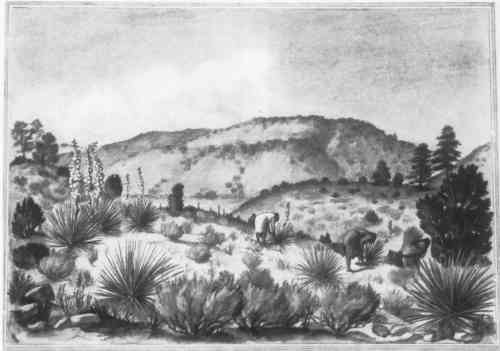AIR-COUPLED ULTRASONIC SYSTEM: A NEW TECHNOLOGY FOR DETECTING FLAWS IN PAINTINGS ON WOODEN PANELSALISON MURRAY, MARION F. MECKLENBURG, C. M. FORTUNKO, & ROBERT E. GREEN
3 SAMPLES3.1 SIMULATED PANEL PAINTINGSSamples were used to mimic panel paintings in order to test the capabilities of the air-coupled ultrasound technique. The samples were constructed with different supports, surfaces, and flaws; each sample varied one of these parameters at a time. The supports included white oak (1.6 cm thick), tulip poplar (2.0 cm thick), and hardboard (0.5 cm thick). Each sample was approximately 15 � 15 cm. Oak, a ring-porous hardwood, and poplar, a diffuse-porous hardwood, were chosen as they represent some of the woods used in panel paintings. The surface layers were added so as to mimic the surfaces of paintings and other museum objects. They included gesso, gesso with linen, wood veneer, and paper. The gesso was made from a weak hide glue and calcium sulphate. The mahogany veneer was 0.5 mm thick. The veneer and paper were glued to the supports with hide glue. Splits were made in the support layer before the surface layer was added by bending the wood over a hard edge. Areas of cleavage were made by placing a layer of gesso on a thin plastic sheet, allowing it to dry, removing the plastic sheet, and gluing the gesso onto the support with hide glue. Other methods were tried by placing either wax or a very thin plastic sheet between the support and the upper layer. These methods did create cleavage; however, the first method described was most similar to what is found in actual objects. The splits, delaminations, and cleavage were imaged in all the 24 samples examined, of which 4 will be discussed here: an oak support that has a split and a After the samples were made, they were placed for 1 month in a sheltered area outside where the temperature varied between −7.2 and 18.9�C and the relative humidity between 27 and 100% RH. The samples were then placed for 1 month in a room where the relative humidity on a daily basis was 100% for short periods and for the rest of the time varied between 27 and 50%. The temperature was between 20.6 and 25.6�C. 3.2 PAINTINGSThe first painting examined was a cradled panel painting from the 17th century (figs. 2a, 2b). It is believed to be a studio copy of Gerard Terborch's painting from 1654–55, known under various titles including Parental Admonition, Paternal Advice, and The Brothel Scene. The painting, from the collection of Dr. and Mrs. Hans Goedicke, Baltimore, Maryland, measured 37 � 49 cm and was made of two planks of radially cut oak. The thickness varied between
The painting served to test the ability of air-coupled ultrasound to detect checks and splits. Above the young woman's head was a check, measuring only 4 cm in length on the front but 34.5 cm on the back. The front of the panel had three very visible open splits in the wood. Only two splits could be seen from the back as the cradle covered the third; however, all splits could be seen in the xeroradiograph (fig. 12).
Evidence existed of a prior cradle; the fact that the wood was lighter in some areas suggested that these areas had been covered by a different cradle. The splits, checks, and disjoins in the panel, including the disjoin between the planks, were probably caused by the cradles. The second painting examined, Women Gathering Yucca Plants (collection of the National Museum of American Art, Smithsonian Institution), by an unidentified artist, was a 20th-century watercolor and ink painting on illustration board mounted on hardboard (fig. 3). The size of the composite structure was 28.2 � 37.8 cm, and the thickness was 6 mm. Delaminations between the illustration board and the hardboard could be seen along the edges, but the exact condition in the central areas was difficult to determine.
|



